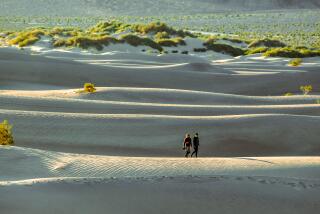Magnifique
--For a fall color experience, there can’t be many places as glorious as this. We’re talking leaves of the appropriately brilliant hues here, of course. Mountains, lakes, villages, inns and art. A great, scenic river, plus people who speak and cook and celebrate life in fluent Quebecois.
Plus whales and seals. Vermont, a rival of sorts, doesn’t have whales or seals. And a lot of this region, Charlevoix, is in a crater.
“It is a very big crater, yes,” said a lad named Mattieu Fortin working an info office outside Baie-Saint-Paul. “We are a mountain in the middle of a crater.”
The crater is within Charveloix, in official Canadian a “regional county municipality.” What that means exactly isn’t as important as pronouncing the name properly: Shar-luh-vwah. (As opposed to Michigan’s Charlevoix, which is pronounced Shar-luh-voy. As in Ill-in-oy. Never mind Joli-ette and De-troyt. We now offer our apologies to the French and return to our story.)
The fact that part of the place was formed by a massive meteorite millions of years before most of us were born is of great interest to geologists and astronomers and UNESCO, which for this and other reasons declared it a Biosphere Reserve 23 years ago. For the rest of us, it’s mainly all the things mentioned in the first two paragraphs, which should be more than enough.
The regional-county-municipality line is about an hour’s drive east of charming Quebec City and just ahead of the first “Watch for Moose” sign. The whole of Charlevoix, crater included, is just a little bigger than Rhode Island--but not only is it much nicer than Rhode Island, there’s a lot of very good stuff to be savored in this pleasant little corner of French Canada. The first hint that this is not your average fall color stop is the view from a ridge above the town of Baie-Saint-Paul. It is the kind of wonderful view that doesn’t translate nearly as well in a photo (film or digital) as it does on canvas, which is why Jacques Boisvert was applying color with brushes to stretched cloth.
“There’s a special feeling around,” said Boisvert, a French-Canadian who apologized unnecessarily for his accented English. “It might be the Saint-Laurent. Because it’s half sea and half river and in the salt, we have something which is good for the air.”
The Saint-Laurent--the “St. Lawrence” in Ontarian--is inescapable. The primary road across the region (La Route du Fleuve/The River Drive) changes numbers from time to time (362 here, 138 there), but it never strays too far from the river that is the aorta of eastern Canada.
Cottages, hotels and auberges position themselves to view it, villages and towns were created to service those who made their livings on it, and for those of us who merely visit, it does bring a certain calm to things.
A retired nurse who travels to La Malbaie every fall from Toronto spoke of it as she attempted to find words for the magic of this place.
“It’s the river. The romance of the river,” she said. “And it’s the light. We love the light. There are certain parts of the world where the light is beautiful, and this is one of them.”
When Boisvert spoke of “the air,” perhaps this was what he was trying to say--the special saline light that draws artists who draw the land and water and sky.
They also sell here.
“Just in the village,” Boisvert said, nodding toward Baie-Saint-Paul below, “we have 34 galleries. It’s more than in Quebec City.”
So art lovers, and those who make art, come here. So do active folks eager to hike and bike and fish and even kayak. Charlevoix is home to a pair of Canada’s national parks, Parc national des Grands-Jardins and Parc national des Gorges-de-la-Riviere-Malbaie. The names suggest one is about big gardens, the other about river gorges, and that’s correct, as far as it goes. Think mountains where, perhaps, you don’t expect to find them.
What we’re talking about here--especially in fall color season--is, if you’ll pardon the French: grandeur. Advised young Monsieur Fortin: “People do one of the parks, and the whales.”
Whales--because they’re whales--never lose their ability to fascinate. These swim up the Atlantic coast, most of them, and into the tidal estuary that is the eastern St. Lawrence each summer to do what whales do: eat. Blue whales, humpbacks, finbacks and minkes. White belugas stay year-round, as do the gray seals--but as fall approaches, the blues and humpbacks head back out to sea and toward the Caribbean. By October, of the migrants, only minkes and fins remain. ...
“Big whale at 11 o’clock!” The eyes of the 50 or so passengers snap, as ordered by a narrator named Martine, toward the vacant chop off the port bow and see nothing--until the blow.
“Whooooh.” It is the universal sound made by people of all languages upon seeing a whale spout steam and rise to the surface. Every time.
“The fin whale,” Martine explains, first in French and then in English, “can dive for 20 to 30 minutes.” Some listen, some stare at the water hoping for more. “They’re eating all the time, so they are very, very active . . . “
And then: “Whooooh” . . .
The whale excursions use boats as small as eight-passenger zodiacs up to cruise vessels capable of carrying enough passengers to successfully invade and occupy New Hampshire.
That all the above--whales, plus dazzling foliage and the villages and lakes and hiking trails and Quebec-French cuisine and all the rest--is nicely do-able on a quick (say, two-day) excursion out of the Americas’ most European city is an embarrassment of possibilities.
Valerie Andree Authier grew up in Charlevoix. Today she is second-generation owner-manager of La Pinsonniere, one of the premiere auberges in all Canada.
“This region,” she said, looking out past the reds and golds of the maples toward the Saint-Laurent from a deck of the inn, “has inspired so many painters and so many artists with its beauty. And this river is beautiful. And the mountains ...”
Another artist, Michel Boisvert (no relation to Jacques) of Baie-Saint-Paul, put it all into an artist’s perspective.
“The color,” he said, “is very special in Charlevoix.”
And never more so than in nature’s most colorful season.
If you go
GETTING THERE
The Charlevoix region begins about an hour’s drive northeast of Quebec City via a mix of residential streets and expressway; the first significant town, Baie-Saint-Paul, is 30 minutes farther. From Baie-Saint-Paul to Baie-Sainte-Catherine (and the whale-watching) at the far end is another 65 miles. United Air Lines offers non-stop service to Quebec City from O’Hare; we found a weekend round-trip fare of about $544 (including taxes and fees, subject to change).
WHEN TO GO
While no date for “peak color” is a sure thing anywhere, Charlevoix’s variable altitudes--from sea level to mountains in minutes--mean if there’s no color one place, there may be fabulous color somewhere else. That said, try early October.
GETTING AROUND
You’ll need a car. The good news is distances are reasonably modest; you can base in La Malbaie and be within an hour of most anyplace in Charlevoix. And while not essential, away from the tourist centers a little basic French won’t hurt.
STAYING THERE
The classic Charlevoix lodging is the auberge--the inn--often a vintage property that serves dinner (and sometimes lunch) along with breakfast, the latter usually included in the rate. Prices range from about $80 into the hundreds; average is about $150. Less expensive B&Bs (locally, gites) are just about everywhere. Though less common, motels--almost all of them independents--can be found in and near the larger towns.
Note that in September and October, in many lodgings some rates may inflate a bit, and minimum stays can kick in.
In Baie-Saint-Paul, where auberges abound, I didn’t regret choosing Auberge La Muse (doubles from about $110, subject to change; 800-841-6839; www.lamuse.com), with nice rooms and an ideal location. Of the “destination” lodgings, two stand out: The castle-like Fairmont Manoir Richelieu (800-257-7544; www.fairmont.com) in La Malbaie is on the St. Lawrence with its own golf course, casino and spa. Smallish doubles in leaf season start as low as $199. The other, La Pinsonniere (800-387-4431; www.lapinsonniere.com), in Cap-a-l’Aigle just outside La Malbaie, is a luxury auberge: 18 rooms, all fine, some sumptuous, most with marvelous river views, plus a full spa and one of the most honored kitchens in all Quebec. Low-season doubles start at $285; during leaf season, it’s $335.
DINING THERE
Along with the region’s natural beauty and artists, this is a prime reason people come to Charlevoix. The tendency is French, the emphasis is on freshness. Most of the better dining is in the auberges, whose dining rooms are generally open to the public (reservations strongly advised, especially on weekends). Sampled two auberge meals on this trip, and neither disappointed: La Pinsonniere lived up to its rep (and hefty price tag); and chef Hank Suzuki’s dinner at Auberge La Muse was a cross-cultural delight.
INFORMATION
Tourism Charlevoix, 800-667-2276; www.tourisme-charlevoix.com.
--Alan Solomon
More to Read
Sign up for The Wild
We’ll help you find the best places to hike, bike and run, as well as the perfect silent spots for meditation and yoga.
You may occasionally receive promotional content from the Los Angeles Times.






